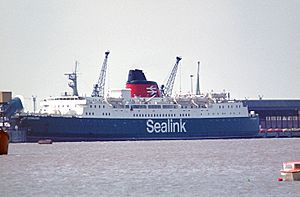MV St Edmund facts for kids
class="infobox " style="float: right; clear: right; width: 315px; border-spacing: 2px; text-align: left; font-size: 90%;"
| colspan="2" style="text-align: center; font-size: 90%; line-height: 1.5em;" | 
|} The St Edmundwas a large ferry built in the early 1970s. It was designed to carry cars and passengers. This ship played an important role during the Falklands War. After the war, it served in different parts of the world, especially in the Mediterranean.
Contents
| History | |
|---|---|
| Name |
|
| Operator |
|
| Builder | Cammell Laird Shipbuilders Ltd., Birkenhead |
| Launched | 14 November 1973 |
| Christened | 14 November 1973 |
| In service | 19 January 1975 |
| Out of service | 2009 |
| Fate | Broken Up |
| General characteristics | |
| Tonnage | 8,987 gross register tons (GRT) |
| Length | 131.06m |
| Draught | 5.18m |
| Depth | 12.8m |
| Decks | 7.6m |
| Installed power | 20,400 shp |
| Speed | 21,0 knots |
| Capacity | Main Deck: 1,400 passengers, 140 cars or 40 x 30m road haulage vehicles Gallery Deck: 148 Cars |
St Edmund in British Rail Service
The St Edmund was officially named on November 14, 1973. This ceremony took place at the Cammell Laird shipyard in Birkenhead. The ship was supposed to be launched a day earlier, but bad weather caused a delay.
After being built, the St Edmund went through tests at sea. In December 1974, it began its service for British Rail. It operated under the Sealink brand. Its main job was to carry passengers and cars between Harwich in England and Hook of Holland in the Netherlands. The ship worked on this route until May 1982. At that time, the Ministry of Defence needed it for a special mission.
St Edmund and the Falklands War
On May 12, 1982, the Falklands War had just started. The St Edmund was quickly taken over by the Royal Navy. From May 13 to May 19, the ship was changed at HMNB Devonport. It was turned into a troopship, which is a ship that carries soldiers.
Workers added two helipads for helicopters. They also installed a satellite communication system. Two freshwater generators were put in place. This allowed the ship to make its own drinking water. Equipment for refueling at sea was also added.
On May 20, the St Edmund left Devonport. It sailed towards the Falkland Islands. It carried soldiers from the 5th Brigade and some members of the Royal Air Force. On June 30, the St Edmund transported Argentine Prisoners of War to Puerto Madryn.
After returning to the Falklands, the ship helped move troops. It ferried soldiers between the Falklands and Ascension Island. Later, it became a floating hotel for soldiers at Port Stanley. On July 17, the St Edmund took more troops to Ascension Island. The ship then returned to the UK. On January 28, 1983, the Ministry of Defence officially bought the St Edmund from British Rail.
Keren: A New Name and Role
In 1983, the St Edmund was formally made part of the Royal Navy. It was given a new name: HMS Keren. A crew of 35 Royal Navy sailors began to learn how to operate the ship. They were preparing to take it back to the Falklands. However, just a few weeks later, HMS Keren was no longer a Royal Navy ship. It became MV Keren, meaning it was a civilian ship again.
In May 1983, the Keren sailed back to the Falklands. It was used as a floating landing stage. This helped other ships dock and unload. Extra refrigerated storage was added to its car decks. A new water plant was also installed. These changes allowed the Keren to hold about 1000 troops. In July 1985, the Keren returned to the UK. After some repairs, it was put up for sale near Portsmouth.
St Edmund in Later Service
In January 1986, the Keren was sold to the Cenargo Group. This company operated the Ferrimaroc ferry service. The ship was renamed Scirocco. It then sailed between Almería in Spain and Nador in Morocco. For a few months in 1986, it was rented by another company, Tirrenia di Navigazione. It operated routes in Italy, including between Genoa and Sardinia. In 1987 and 1988, it was rented by other companies for routes in the Mediterranean. These included Barcelona to Palma and La Goulette to Marseille.
On January 8, 1989, the ship arrived in Southampton for repairs. By February, it was rented by British Channel Island Ferries. It was renamed Rozel and sailed from Poole to Guernsey and Jersey. In January 1992, it returned to its previous owner and became Scirocco again. It then operated the Málaga to Melilla route. On May 16, 1993, it went back to the Ferrimaroc service. It sailed the Almeria to Nador route under the Gibraltar flag.
During the summer of 1993, the ship was rented by COMANAV. It operated the Nador to Port-Vendres service. In 1994, it was used on the company's Genoa to Tunis route. On March 15, 1994, the ship returned to Ferrimaroc's Nador - Almeria route. It stayed on this route until 2004. Then, it was sold to El Salam Maritime Transport in Egypt. It was renamed Santa Catharine I. It was again rented by COMANAV for the Nador to Port-Vendres route.
In 2005, it was rented by Algerie Ferries. It was used for pilgrim services from Suez. On May 30, 2006, it was renamed Sara 3. It operated on a route between Jeddah and Sawakin. In June 2009, the ship was sold to companies in India. It was then broken up for scrap.

